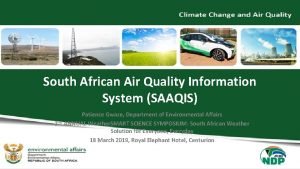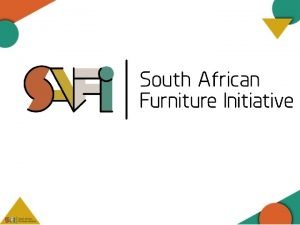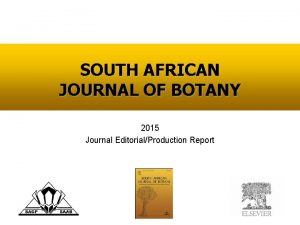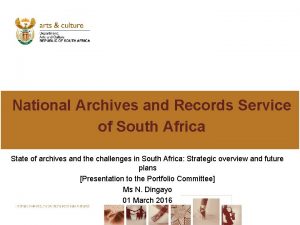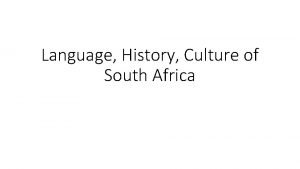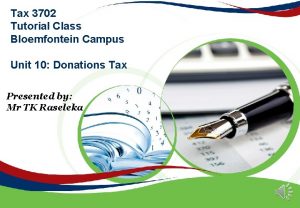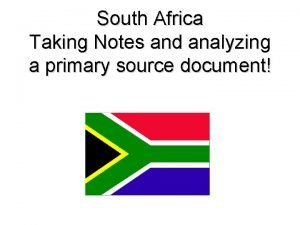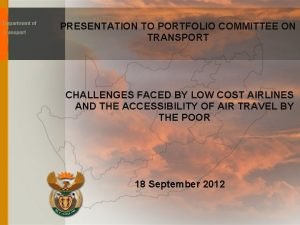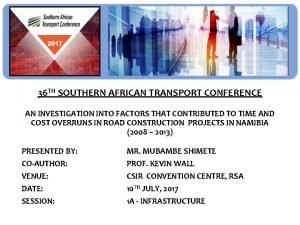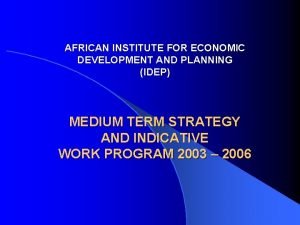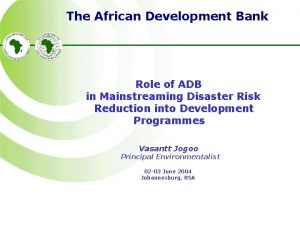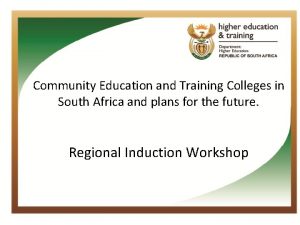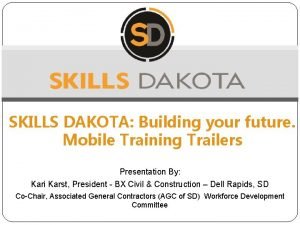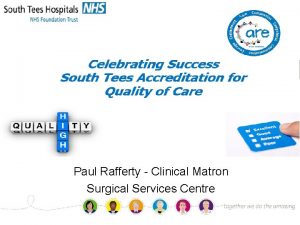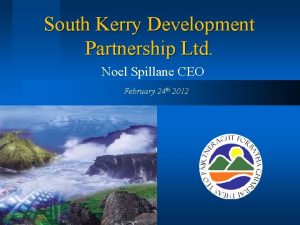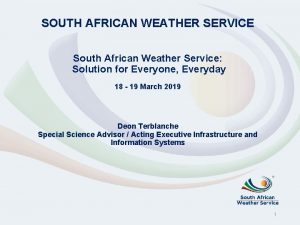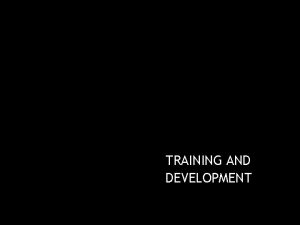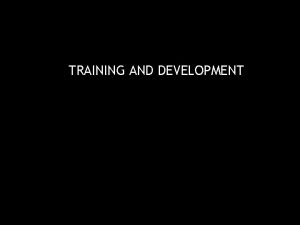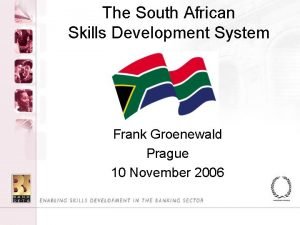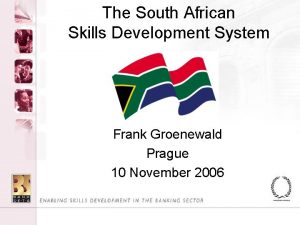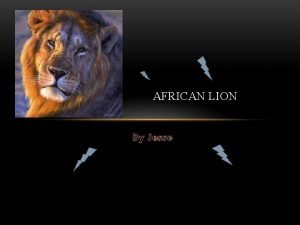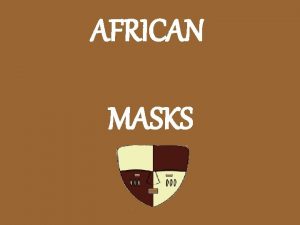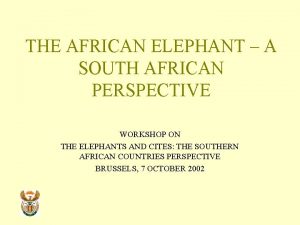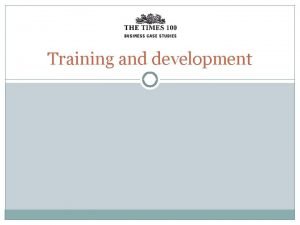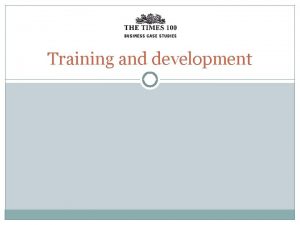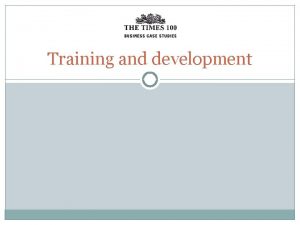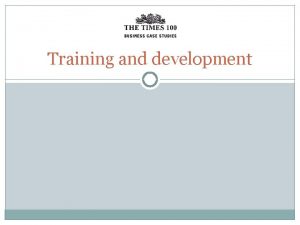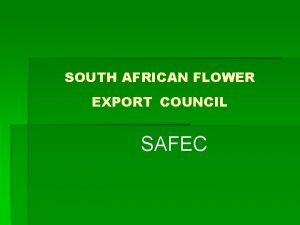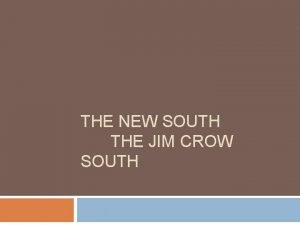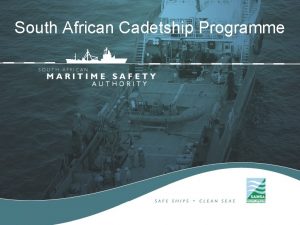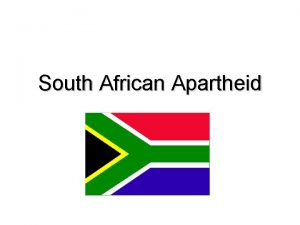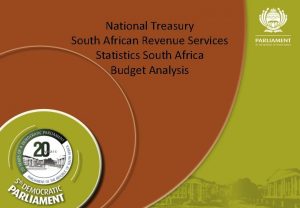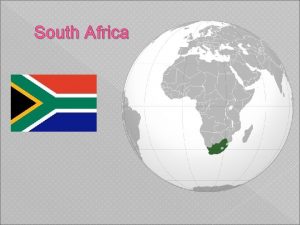Training and skills development in the South African








































- Slides: 40

Training and skills development in the South African audio visual industry by Natalie Delport

2

Legislation: The 3 Acts • South African Qualifications Authority Act No. 58 of 1995 • Regulations under the SAQA Act (R 452 of 1998) • NSB Regulations 1998 • Skills Development Act No. 97 of • ETQA Bodies Regulations 1998 • Regulations of Learnerships and Skills Programmes 1999 • Skills Development Levies Act No. 9 of 1999 • Regulations on the SDL Act, 1999 3

Skills Development NSF Public & Private Providers Employer Providers 4

South African Qualifications Authority (SAQA) The body responsible for overseeing the development and implementation of the National Qualifications Framework (established in terms of the SAQA Act no. 58 of 1995) 5

SAQA To oversee the development of the NQF, by formulating and publishing policies and criteria for the registration of bodies responsible for establishing education and training standards or qualifications and for the accreditation of bodies responsible for monitoring and auditing achievements in terms of such standards and qualifications. 6

Consultation Panels Appointed by SAQA 1. Agriculture and Nature Conservation 2. Culture and Arts 3. Business Commerce and Management Studies 4. Communication Studies and Language 5. Education Training and Development 6. Manufacturing, Engineering and Technology 7. Human and Social Studies 8. Law, Military Science and Security 9. Health Science and Social Services 10. Physical, Mathematical, Computer and Life Sciences 11. Services 12. Physical Planning and Construction 7

Standards Generation Function NQF NLRD Qualifications Unit Standards 8

Outcomes Based Education (OBE) According to the National Department of Education’s Policy Document (1997), outcomes-based education (OBE) should be driven by the outcome displayed by the learner at the end of the educational experience 9

Principles of OBE Recognition Self-paced learning Equity Flexibility Learner centered Facilitation Learning in real-life situations Critical thinking, reasoning, reflection, action Continuous integrated assessments Learner responsibility 10

National Qualifications Framework (NQF) The NQF is a structure that organises and classifies qualifications and competencies in South Africa. It consists of registered unit standards and qualifications at eight levels of learning. . . 11

NQF System 12 Standards and Standards Qualifications 12

NQF LEVELS Education band Higher Further NQF Level Qualification Institutions 8+ 8 7 6 5 Doctors degrees, post-doctoral research/ Masters Honors and four-year degrees First degrees/Higher certificates Universities, Universities of Technology Colleges, Private Providers, In-house/workplace training 4 - Gr. 12 3 - Gr. 11 2 - Gr. 10 Further Education and Training Certificate Schools, colleges, private providers, training centers, NGOs, in-house/ workplace training General Open-ended 1 - Gr. 9 General Education and Training Certificate ABET levels 1 to 4 Early Childhood Development Schools, ABET providers, independent schools, NGOs, nursery schools, private providers 13

NQF Principles 1. Integration To form part of a system of learning that provides for a unifying approach to education and training 2. Relevance To be responsive to national development needs 3. Credibility To have international and national value, recognition and acceptance 4. Coherence To work within a consistent framework of principles and certification 5. Flexibility To allow for multiple ways of achieving the same learning ends 6. Standards To be expressed in terms of a nationally agreed framework and internationally acceptable outcomes 7. Legitimacy To provide for the participation of national stakeholders in the planning and coordination of standards and qualifications 8. Access To provide access to appropriate levels of education and training for all prospective learners 9. Articulation To enable learners, on successful completion of learning, to move between providers and qualifications 10. Progression To ensure that the NQF permits individuals to move through the levels of national qualifications 11. Portability To enable learners to transfer credits of qualification from one learning institution and/or employer to another 12. RPL To give credit, through assessment, to learning already acquired in different ways 13. Guidance of To provide for counseling of learners by specially trained individuals who meet nationally recognised standards for educators and trainers 14

Skills Development Levy (SDL) Skills Development Levy. This is a levy (of 1%) payable and collected by the South African Revenue Services (SARS) by employers who pay more than a certain figure of salaries per year. 15

Skills Development Levy (SDL) Whether you pay R 50 or R 5 000 per month for Skills Development Levy, you are entitled to get back a portion of the money you have paid in the form of Levy Grants. A simplified form has been developed to make grants more accessible to all companies. 16

Skills Development Levy (SDL) Mandatory Grants = 50 % (through WSP submission) Discretionary Grant = TBC (Special Calls via SETA’s) 17

Workplace Skills Plan (WSP) The company training plan approved by the relevant SETA… 18

Workplace Skills Plan (WSP) Companies with 50 or more employees (temporary and permanent employees), will complete the Workplace Skills Plan and Annual Training Report annually SETA provides templates. 19

Quality Assurance Systems International System National Systems Moderation DOL SME Assessors SETA DOE SGB Management SAQA and ETQAs ISO & IIP 20

21

The Assessment Process Moderated and Verified Delegate asks to be assessed Certification by SETA Assessment of POE & Feedback to/from Learner Assessment is planned Practical (workplace) & Knowledge (written/oral) Assessment takes place - in the workplace 22

What is an Assessment? Assessment is a process of identifying, gathering and interpreting information about a learner’s achievement, as measured against nationally agreed outcomes for a particular phase of learning 23

What is an Assessment? FOUR STEPS IN ASSESSMENT Generating and collecting evidence of achievement Evaluating this evidence against the outcomes Recording the findings of this evaluation Using this information to assist the learner’s development and improve the process of learning 24

Competence Model for Assessments KNOWLEDGE Cognitive Foundational Head Read Mind SKILL Psychomotor Practical Hand Do Body ATTITUDE Affective Reflective Heart Think Soul 25

Quality Assurance Function Quality of Learning 26

Assessment Support System ETQA Verifiers Moderators Assessors and Assessment Designers Evidence Collection Facilitators 27

Appeals Procedure Assessment Dissatisfied candidate Moderation Appeal to provider Dissatisfied candidate Verification Appeal to ETQA Appeal to SAQA Dissatisfied candidate 28

Types of Assessment FORMATIVE SUMMATIVE Active support during learning process At end of learning programme Identify learner strengths and weaknesses Determines overall competence Provide feedback on progress Assessment against unit standards Developmental To obtain credits Prepares for summative assessment 29

Types of Evidence Direct Indirect Historical Observation in the workplace Testimonials Certificates Affidavits Logbooks References Testimonials Written Tests and Examinations References Simulations Role Plays Case Studies Video and Audio Tapes Life Experience Peer Reports Products Answers to Questions 30

Critical Cross-Field Outcomes Identify a problem and know how to solve it. Display interpersonal skills. How does the learner relate with others? Ability to plan his/her own activities. Is he/she organised or disorganised? Collect, analyse and evaluate information. Communicate verbally or in writing. Does the learner write down information like figures correctly? Display responsibility and conscientiousness when working with tools. Care for the environment and others. Care for the safety of others. Display awareness of the world as a set of interrelated systems. 31

Assessment Principles Method Evidence Process Fair Valid Systematic Appropriate Authentic Open Integrated into world of work Current Reliable (Consistent) Manageable Sufficient 32

Rules of Evidence V VALID A AUTHENTIC C CURRENT S SUFFICIENT 33

Assessment Methods Method Strength Weakness Observation Direct evidence, reliable, authentic Time consuming, stressful, intimidating to learner. Written Tests Time saving, assess knowledge, documented evidence, authentic, easy to mark Does not assess skill on its own. Fear of writing tests. Language problems. Learners lack exam technique Verbal questioning Can clarify questions, can expand on questions, can watch learner behaviour Time consuming, stressful, inclination of assessor to lead learner. Interviews As above. More structured, can use panel of assessors. Stressful. Learners become skilled interviewees. Documents Documented proof. Can assess prior achievements. Authenticity. Relevance. Currency. Validity. Difficult to determine these. Portfolios A collection of evidence. Structured. Referenced. Too much irrelevant information. Unstructured. Authenticity. Simulations Represents real-life situations. Safe. Not the real thing. Costly to lay out. 34

Format of a Unit Standard U. S. title Field of Learning Issue and Review dates Assessment Criteria Accreditation Process U. S. number Purpose Range Statements NQF level Learning Assumed Essential Embedded Knowledge Credit value Specific Outcomes Critical Crossfield Outcomes SAQA logo 35

Assessment Documentation • Application for Assessment (based on U/std or Qual ID) • Moderator Report • SETA Moderator Report Moderated and Verified Delegate asks to be assessed • Assessment Planning • Confirm Assessment (to all parties) Assessment is planned Certification by SETA • Statement of Results (SOR) from SETA • Add to NLRD Assessment of POE & Feedback to/from Learner • Assessment Instruments • Checklists Practical (workplace) & Knowledge (written/oral) Assessment takes place - in the workplace • Assessor judgement (C or NYC) • Assessor Feedback • Learner Feedback • Assessor Review • Send to Moderator • Submit to SETA 36

Questions? Facilitator: Natalie Delport / Jeniffer Maako Cell: 082 906 0224 / 072 423 7999 Fax: 086 572 6224 E-mail: natalie@portaltolearning. co. za jeniffer@portaltolearning. co. za www. portaltolearning. co. za 37

38

SHORT COURSES: What is a Short Course? A short course is a type of short learning programme through which a learner may or may not be awarded credits, depending on the purpose of the programme. A Credit-bearing short course is a type of short learning programme for which credits, in relation to the course's contribution to a particular programme, unit standard and/or (part) qualification, is are awarded. (Paraphrased from CHE, 2001: 44). A credit-bearing short course contains less than 120 credits. A Non-credit-bearing short course is a type of short learning programme for which no credits are awarded in relation to unit standards or (part) qualifications depending on the purpose and/or assessment of the programme. 39

REGISTRATION OF NEW STANDARDS AND QUALIFICATIONS: What is the difference between a qualification and a learning programme, and can a programme be registered on the National Qualifications Framework? The essential difference between a qualification and a learning programme is that a qualification is a learning outcome, and a learning programme the process one embarks upon in fulfilment of that outcome. A qualification means the formal recognition of the achievement of learning. A learning programme on the other hand is the process which one embarks upon in order to fulfil that achievement. A qualification is characterized by learning outcomes - critical cross-field and specific outcomes - which provide the learner with opportunities for further (lifelong) learning. Subject to SAQA approval, a qualification can be registered on the National Qualifications Framework. Once thus registered, the qualification becomes "public domain property". A learning programme is a provider-specific course or programme offered to learners against a particular qualification, and is subject to quality assurance by an accredited ETQA. Learning programmes, then, cannot be registered on the National Qualifications Framework. 40
 Hamilton naki biografia
Hamilton naki biografia Saaqis
Saaqis South african furniture initiative
South african furniture initiative South african journal of botany impact factor
South african journal of botany impact factor National archives and records service
National archives and records service The south african apartheid
The south african apartheid Hartswater bosluis
Hartswater bosluis South african tax
South african tax Sacap contact details
Sacap contact details South african freedom charter pdf
South african freedom charter pdf South african tax
South african tax 1994 apartheid
1994 apartheid South african council for natural scientific professions
South african council for natural scientific professions South african principals association
South african principals association South african transport conference
South african transport conference Southern african transport conference
Southern african transport conference African institute for economic development and planning
African institute for economic development and planning African development bank adb
African development bank adb Old south vs new south streetcar named desire
Old south vs new south streetcar named desire Community colleges in south africa
Community colleges in south africa South west and wales doctoral training partnership
South west and wales doctoral training partnership How to improve intrapersonal skills
How to improve intrapersonal skills Soft skill vs hard skill
Soft skill vs hard skill Skills usa south dakota
Skills usa south dakota South tees mandatory training
South tees mandatory training Essential skills ontario
Essential skills ontario Historical development of community development
Historical development of community development Human resource development council of south africa
Human resource development council of south africa Skdp jobs
Skdp jobs Hát kết hợp bộ gõ cơ thể
Hát kết hợp bộ gõ cơ thể Ng-html
Ng-html Bổ thể
Bổ thể Tỉ lệ cơ thể trẻ em
Tỉ lệ cơ thể trẻ em Voi kéo gỗ như thế nào
Voi kéo gỗ như thế nào Thang điểm glasgow
Thang điểm glasgow Chúa yêu trần thế alleluia
Chúa yêu trần thế alleluia Môn thể thao bắt đầu bằng chữ f
Môn thể thao bắt đầu bằng chữ f Thế nào là hệ số cao nhất
Thế nào là hệ số cao nhất Các châu lục và đại dương trên thế giới
Các châu lục và đại dương trên thế giới Công của trọng lực
Công của trọng lực Trời xanh đây là của chúng ta thể thơ
Trời xanh đây là của chúng ta thể thơ

